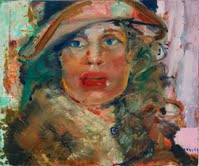
Things fall apart…at least in the recent paintings of Angela Dufresne, whose works are in a two-gallery exhibition at Monya Rowe and CRG entitled Parlors and Pastorals. That is the impression at first glance: nominal landscapes and scenes of bourgeois interiors, these paintings, awash with color and executed with an impressive arsenal of painterly paint handling, are slipping glimpses into scenes both real and imagined, caught in a state of permanent contingency.
"Alphaville Sublime" (2012) and "Putting out in the Parlor of King Alexander" (2012) are a good starting point in the immersive world that Dufresne has created, which was ostensibly inspired by Buster Keaton's "The Playhouse" (1921), a play-within-a-play-within-a-play tour de force of early filmmaking. Dufresne applies the same methodology of stripping away illusions of reality and notions of continuity, and, like Keaton, uses physicality (in all its humorous aspects) to present something like paintings of pictures of paintings being painted. With references to Alphaville (1965), Godard's inversion of the science fiction genre, and the ornate stage-managed theatrics of Regency French painting, these large canvases play with a lexicon of styles and handling that incorporates elements of Giacometti, Mathieu, Hartigan, and Richter, with paint slathered, washed, scraped, jotted, scumbled, and wiped away as she works -- layering image over image until finally arriving at, or rather, walking away from, a picture of suspended gesture. In "Lady David-Rosemary Angeles in a Golden Swamp" (2012), the artist inverts the gender of Bernini's David, combining portraits of her mother and herself into a hybrid figure in a landscape inspired by Albert Bierstadt of trees in the Hudson Valley. An exploration of Tiepolo's "The Banquet of Cleopatra" (1743-44) is mashed-up into "Banquette Concerto with Head" (2012): the balustrade in the original Baroque painting becomes a rope bridge, the table centerpiece a severed head.
Dufresne resurrects the old-fashioned notion of the painterly "sketch," something we have perhaps forgotten after a century of Modernism. We used to distinguish between the working sketch or étude (study) -- a notational, almost mnemonic, device -- and the full sketch, or ébauche -- a true canvas, usually monochrome, which recorded the artist's raw, alla prima impressions. Tiepolo, Velázquez, and Tintoretto were masters of the sketch; Delacroix, in spite of his pissing on about "finished" masterpieces, was its last great practitioner. In our time, with information flowing faster than ever, breathing new life into this painterly genre seems more relevant than retro.
There is something sweetly sincere about "Hanna Schygulla Again Because There Can't Be Too Much of Her" (2012 [above]). This tiny study of Rainer Werner Fassbinder's favorite muse calls to mind Fassbinder's penchant for making movies about making movies. It also slows Dufresne's brush, limits her field of play, and allows the paint to coalesce and build. It provides a nice counterpoint to the larger pieces, a moment of quiet against the high theater of the larger works. Its intimate scale allows us a closer look at Dufresne's method and reveals more of the painter. Barnett Newman wrote, "Painting should give one a sense of place: that one knows he's there, aware of himself. In that sense he relates to me when I made the painting, because in that sense I was there…to me that sense of place has not only a mystery, but has that sense of metaphysical face. I hope my painting has the impact of giving someone, as it did to me, that feeling…of connection to others." Yeah, a lot to pin on a portrait of a German B-movie actress, but Dufresne somehow manages to do it. And in the room the women come and go, talking of Michelangelo.... - Bradley Rubenstein
